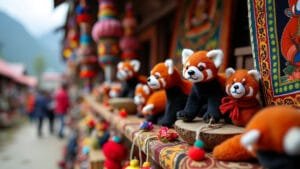Introduction
The red panda holds a special place in the mythology and cultural practices of indigenous communities in Nepal. Often seen as a guardian of the forest and a symbol of balance and harmony with nature, the red panda is deeply connected to the spiritual beliefs of the people who share its Himalayan habitat
In traditional myths, red pandas are often portrayed as protectors of sacred forests, embodying the delicate relationship between humans, animals, and the environment. This article explores the spiritual significance of the red panda in indigenous Nepali mythology, the stories and legends surrounding it, and how these beliefs play a role in modern conservation efforts
Spiritual Significance of the Red Panda in Nepali Indigenous Mythology
The red panda holds deep spiritual meaning in the mythology of several indigenous communities in Nepal, particularly those living in the eastern Himalayas
These communities have long regarded the red panda as a sacred animal that embodies balance and protection within the natural world. Its role as a guardian of the forest and its connection to forest spirits make it a key figure in the spiritual beliefs of the region, symbolizing the delicate harmony between humans and nature
The Red Panda as a Guardian of the Forests
In Nepali indigenous mythology, the red panda is often viewed as a guardian of the forest. The people living in the red panda’s natural habitat, such as the Sherpa, Limbu, and Tamang communities, believe that the red panda protects the sacred forests where many deities and spirits reside
These forests are seen as living, spiritual entities that provide balance to the earth, and the red panda plays a critical role in maintaining that balance
The presence of red pandas in these forests is thought to indicate the health of the environment. When red pandas are seen, it is believed that the forest is thriving and in harmony with the natural world
Conversely, their absence or decline is viewed as a sign that the forest is in danger or has been disrupted by human activity, such as deforestation or overuse of resources. This belief reinforces the red panda’s role as a protector of the natural environment, and harming or disturbing the red panda is seen as an act that could anger the spirits of the forest
Symbolism of Balance and Harmony with Nature
The red panda’s solitary and peaceful nature has led to its symbolism as a creature that embodies balance and harmony. In Nepali mythology, red pandas are often associated with the balance between the earth and the sky, as well as between the natural and spiritual worlds
Their quiet, unassuming presence in the forest is seen as a reflection of the harmony that exists within the ecosystem, where every living being plays a role in maintaining equilibrium
The red panda’s diet, which largely consists of bamboo, a resource that grows in abundance but requires delicate management, is also seen as symbolic of balance. Indigenous communities view the red panda’s reliance on bamboo as a metaphor for sustainable living—taking only what is needed from the environment and leaving the rest to ensure future growth
This idea aligns with traditional practices of sustainable resource use that many indigenous groups follow, ensuring that the land and its creatures are cared for in a way that allows for continued abundance
In local folklore, the red panda’s peaceful coexistence with other animals and its low impact on the environment serve as reminders of the importance of living in harmony with nature, avoiding conflict, and minimizing human disruption to natural cycles. This belief has contributed to a cultural reverence for the species, encouraging practices that protect both the red panda and its habitat
Connection Between the Red Panda and Forest Spirits
In many indigenous Nepali communities, forests are believed to be inhabited by spirits and deities that protect the land and its people. The red panda is seen as a physical manifestation of these protective spirits, serving as a messenger or intermediary between humans and the forest gods
In some myths, red pandas are thought to have the ability to communicate with forest deities, alerting them to dangers or disturbances in the natural world
The connection between red pandas and forest spirits is particularly strong in areas where the forests are considered sacred, such as in the Kanchenjunga and Singalila regions. In these areas, red pandas are often seen as sacred animals that must not be harmed. The local belief is that any harm done to a red panda will disrupt the spiritual balance of the forest and bring misfortune to the community
As a result, many indigenous groups have long practiced the protection of red pandas and their habitats, as part of their broader respect for the spiritual and ecological health of the land
This spiritual connection has also led to the inclusion of red pandas in traditional rituals and ceremonies that honor the spirits of the forest. For example, some communities include symbolic representations of red pandas in their festivals, offering prayers and gifts to the forest deities through the red panda as a means of ensuring the continued protection and fertility of the land
Research by Sherpa (2016) highlights the role of the red panda as a spiritual figure in indigenous Nepali mythology, noting that the species’ association with forest spirits has helped promote conservation practices in areas where these beliefs are still strong
The study found that communities that revere the red panda as a guardian of the forest are more likely to engage in conservation efforts that protect both the species and its habitat
Myths and Legends Featuring the Red Panda in Nepali Culture
In the rich tapestry of Nepali indigenous mythology, the red panda holds a special place, appearing in a variety of myths and legends that reflect its role as both a sacred animal and a symbol of nature’s balance
These stories are deeply rooted in the spiritual traditions of the people living in the eastern Himalayas, and they often portray the red panda as a protector of the forests, a guide to the spirits, and a creature with mystical abilities
Stories of Red Pandas Protecting Sacred Forests
Many Nepali myths tell of red pandas acting as guardians of the sacred forests where spirits and deities reside. In these stories, the red panda is often depicted as a protector, ensuring that the forests remain undisturbed by human activity
In one widely told legend, the red panda is said to have saved a sacred grove from destruction by warning the forest spirits of a looming threat from outsiders who sought to clear the land for agriculture. According to the myth, the red panda’s cries alerted the deities, who intervened to protect the forest and banish the intruders
Such tales reinforce the belief that red pandas have a special connection to the sacred forests, and harming these animals is considered a violation of spiritual law. The forests themselves are seen as places where the material world meets the spiritual realm, and the red panda plays a crucial role in maintaining this delicate balance
This idea of red pandas as protectors of sacred forests serves as an important cultural message, promoting respect for nature and emphasizing the need to preserve these vital ecosystems
In many communities, these stories have helped instill a sense of responsibility toward the environment, as people are encouraged to see themselves as stewards of the land alongside the red panda
Role of the Red Panda in Local Creation Myths
In some indigenous creation myths, the red panda is associated with the origins of life and the natural world. One popular legend from the eastern Himalayas tells of a time when the earth was barren and lifeless
According to the myth, the gods sent a red panda down to the earth to plant the first trees and bring life to the barren land. The red panda’s task was to care for the newly growing forests, ensuring that they would flourish and sustain all living creatures
In this myth, the red panda is not only a protector of the forest but also a creator, responsible for the birth of nature itself. The story highlights the animal’s deep connection to the natural world, portraying it as a being that embodies life, growth, and the cycles of nature
This creation myth is often used in oral storytelling traditions to teach younger generations about the importance of respecting the environment and living in harmony with nature
In other variations of the myth, the red panda is seen as a guide, leading the first humans through the forests and teaching them how to live in balance with the land. In these stories, the red panda serves as a symbol of wisdom and guidance, helping people navigate the challenges of life by showing them the way of the forest spirits
Regional Variations in Red Panda Myths Across the Himalayas
The mythology surrounding red pandas varies between different regions and communities across the Himalayas, with each group offering its own unique stories and interpretations of the animal’s role
In some regions, red pandas are seen as messengers of the gods, believed to carry the prayers of humans to the deities who dwell in the mountains. In these myths, red pandas are often revered as sacred animals that must be treated with great care and respect
In the Singalila region of Nepal, for example, there is a local legend that tells of a red panda who helped a group of travelers find their way through a dense forest after they became lost
According to the story, the travelers had prayed to the forest spirits for help, and the red panda appeared as a guide, leading them safely to the edge of the forest. This story is still told today as a reminder of the red panda’s role as a protector and guide for those who respect the land
In the Kanchenjunga region, red pandas are often depicted in folktales as creatures with the ability to transform into other animals or even humans. These shape-shifting abilities are said to reflect the red panda’s close relationship with the spiritual world, where boundaries between the physical and supernatural realms are fluid
In these stories, red pandas are sometimes portrayed as tricksters, using their magical abilities to outsmart hunters or evade capture, further emphasizing the animal’s sacred and untouchable status
Research by Yonzon (1991) highlights the diversity of red panda myths across the Himalayan region, noting that while the specific details of the stories may vary, the overarching theme of the red panda as a protector and symbol of harmony is consistent
These myths serve as powerful cultural tools, reinforcing the importance of environmental stewardship and respect for the natural world
The Role of Indigenous Beliefs in Red Panda Conservation
Indigenous beliefs in Nepal, particularly those related to the red panda, play a crucial role in the conservation of the species and its habitat
Many indigenous communities view red pandas as sacred animals, and their spiritual reverence for the species has significantly influenced how these communities approach conservation
This deep-rooted respect for nature has fostered practices that align with modern conservation goals, creating a cultural foundation that promotes the protection of red pandas and the forests they inhabit
How Spiritual Reverence Encourages Habitat Protection
For indigenous communities in Nepal, the red panda is more than just a species to be protected—it is a sacred animal that symbolizes the health of the forest
Many of these communities, such as the Sherpa, Tamang, and Limbu, have long believed that harming a red panda or its habitat would anger the forest spirits, leading to misfortune or bad harvests. This belief has historically helped preserve the red panda’s habitat, as these communities actively avoid disturbing areas where red pandas live
This spiritual reverence for the red panda aligns closely with the goals of modern conservation efforts, which focus on protecting the species’ natural habitat. By maintaining traditional practices that respect the balance between humans and nature, indigenous communities contribute to the preservation of the temperate forests that red pandas call home
In regions where these beliefs remain strong, red panda populations tend to be healthier, as the local people play an active role in preventing habitat destruction and poaching
Additionally, the cultural importance of red pandas has encouraged local communities to support conservation initiatives led by external organizations. For example, the Red Panda Network has partnered with indigenous groups in eastern Nepal to protect red panda habitats through community-based conservation programs
These programs work by incorporating indigenous beliefs into their approach, ensuring that conservation efforts are both culturally respectful and ecologically effective
Community Rituals Honoring the Red Panda
Rituals and ceremonies that honor the red panda are common in many indigenous Nepali communities. These practices are often tied to festivals or seasonal events that celebrate the connection between the people and the land
During these rituals, offerings may be made to the forest spirits, with the red panda often symbolizing the health and prosperity of the ecosystem
In some regions, traditional ceremonies are held to bless the forests where red pandas live, asking the spirits for protection and good fortune. These rituals serve as a reminder of the community’s responsibility to care for the land and its inhabitants. The red panda is often seen as a symbol of this responsibility, and its presence in the forest is regarded as a sign that the ecosystem is in balance
One such ritual, observed by the Tamang community, involves lighting incense and offering food at sacred trees believed to be inhabited by forest deities. The red panda, as a guardian of the forest, is honored during this ritual, with villagers praying for the well-being of the forests and all the creatures that live within them
These ceremonies not only reinforce the spiritual significance of the red panda but also strengthen the community’s commitment to conservation
Through these rituals, indigenous beliefs contribute to the protection of red panda habitats by embedding conservation principles into the fabric of cultural and spiritual practices. This blend of tradition and conservation is vital in promoting the long-term sustainability of both the red panda population and the surrounding ecosystem
Integrating Traditional Knowledge into Modern Conservation Efforts
Modern conservation organizations have increasingly recognized the value of traditional knowledge in protecting red pandas and their habitats
Indigenous communities possess a deep understanding of the forests, plants, and animals that inhabit the Himalayan region, and their knowledge is essential for effective conservation strategies. By integrating indigenous beliefs and practices into scientific conservation efforts, organizations can create more holistic approaches that respect local culture while achieving conservation goals
Programs like the Red Panda Network’s Forest Guardian initiative have successfully integrated traditional knowledge into their conservation model
This initiative trains local villagers, many of whom come from indigenous communities, to become forest guardians tasked with monitoring red panda populations, patrolling for signs of poaching, and protecting critical habitats. These guardians use their knowledge of the land, along with scientific tools provided by conservation organizations, to help ensure the long-term survival of red pandas
Another example of integrating traditional beliefs into modern conservation is the promotion of eco-friendly land-use practices that align with indigenous values of sustainability
Many indigenous communities already practice forms of agriculture and forest management that minimize harm to the environment, such as rotational farming and selective logging. Conservation programs that build on these practices are more likely to gain local support and be sustainable in the long run
By working alongside indigenous communities and respecting their spiritual and cultural connections to the red panda, conservation organizations can create programs that not only protect the species but also empower local people
This approach helps ensure that red panda conservation is a shared responsibility, benefiting both the environment and the livelihoods of those who depend on the forest
Research by Miller (2018) highlights the importance of integrating indigenous knowledge into red panda conservation, noting that these practices often align with ecological goals and provide a cultural framework that encourages long-term stewardship
The study emphasizes that successful conservation efforts must involve local communities, respecting their traditions and ensuring that they are active participants in protecting their natural heritage
The Red Panda’s Place in Cultural Identity and Traditions
The red panda plays a significant role in the cultural identity and traditions of many indigenous communities in Nepal
This small, elusive animal is more than just a symbol of the natural world; it represents the deep connection these communities have with their environment and the spiritual beliefs that guide their interactions with the land
The red panda is often celebrated in festivals, ceremonies, and storytelling, serving as a reminder of the importance of balance, harmony, and respect for nature. Its presence in cultural practices reflects the broader values of conservation and sustainability that are central to the identity of many Nepali communities
The Red Panda’s Role in Indigenous Festivals and Ceremonies
In several regions of Nepal, the red panda is honored in indigenous festivals and ceremonies that celebrate the interconnectedness of all living things
These festivals often take place during the spring and autumn seasons, when the forests are particularly vibrant, and the red panda’s presence is more noticeable. The animal is seen as a symbol of the forest’s vitality, and its appearance during these times is considered a good omen
One festival, celebrated by the Sherpa community, involves offerings to the forest spirits, with the red panda as a central figure. During this event, villagers gather near sacred trees, where they light incense and present gifts of food and flowers, asking for the forest’s continued health and the protection of the red panda
This ceremony reinforces the belief that the red panda plays a vital role in maintaining the balance of the forest ecosystem, and its well-being is directly linked to the prosperity of the community
Similarly, the Tamang people honor the red panda during their annual forest blessing ceremonies. These rituals are designed to thank the spirits of the forest for providing food, shelter, and protection, with the red panda acting as a symbol of the forest’s guardianship
In these ceremonies, the red panda is depicted as a quiet, watchful protector, ensuring that the forests remain fertile and undisturbed by human interference. Such traditions underscore the spiritual and ecological importance of the red panda in indigenous belief systems
How the Red Panda Symbolizes Local Values and Ethics
The red panda represents more than just a connection to the forest; it embodies the ethical and moral values of indigenous communities in Nepal. Its solitary, peaceful nature is often seen as a reflection of how humans should interact with their environment—living in harmony with the natural world, taking only what is needed, and avoiding unnecessary conflict
These values are deeply ingrained in the cultural identity of many Nepali communities, shaping their attitudes toward resource use and environmental stewardship
In local storytelling traditions, the red panda is frequently portrayed as a figure of humility and wisdom. Unlike larger, more powerful animals, the red panda survives by staying quiet and out of sight, a quality that is admired in many indigenous cultures
This characteristic is often linked to the idea of living sustainably, taking only what the forest offers without exploiting it. As a result, the red panda is seen as a model of restraint and respect for nature, qualities that are integral to the ethical codes of these communities
Moreover, the red panda’s reliance on bamboo, a resource that grows slowly and requires careful management, is symbolic of the broader principles of balance and patience. Indigenous people in the Himalayas often view the red panda as a reminder to live with mindfulness and moderation, ensuring that future generations can continue to enjoy the bounty of the forest
Red Pandas in Art, Storytelling, and Oral Traditions
Red pandas are not only important in rituals and ceremonies but also feature prominently in the art, storytelling, and oral traditions of indigenous Nepali cultures. Local folklore is filled with stories about the red panda, many of which are passed down through generations to teach lessons about respect for nature, humility, and the importance of living in harmony with the environment
In some communities, red pandas are featured in traditional songs and dances that tell the story of their role as protectors of the forest
These performances are often held during festivals or special occasions, with villagers reenacting the movements and behaviors of the red panda as they sing about its importance. The dances often imitate the red panda’s quiet, deliberate movements through the forest, symbolizing the balance it helps maintain within the ecosystem
Artistic representations of the red panda are also common in indigenous craftsmanship. From wood carvings to textiles, the red panda is often depicted in artwork that celebrates the natural world. These works are not only beautiful but also serve as a form of storytelling, preserving the cultural significance of the red panda for future generations
In many cases, these artistic representations are used to adorn homes or community buildings, serving as constant reminders of the red panda’s role as a guardian of the forest
Oral traditions further cement the red panda’s place in the cultural identity of these communities. Elders often tell stories about the red panda to teach younger generations about the values of conservation and respect for the land. These stories highlight the red panda’s wisdom, patience, and role as a protector, encouraging children to adopt the same principles in their interactions with the environment
By keeping these traditions alive, communities ensure that the cultural and ecological significance of the red panda is passed on, fostering a sense of responsibility toward conservation
Research by Thapa (2020) emphasizes the importance of the red panda in indigenous art and storytelling, noting that these traditions play a key role in maintaining cultural identity and promoting conservation values. The study found that the red panda’s presence in local art and folklore reinforces the community’s connection to the natural world and strengthens their commitment to protecting it
Conclusion
The red panda holds a deep and multifaceted significance in the mythology and cultural identity of indigenous communities in Nepal
As a sacred animal, the red panda is seen as a guardian of the forests, symbolizing balance, harmony, and a vital connection between the spiritual and natural worlds. Through myths, legends, and spiritual reverence, the red panda plays an important role in the traditions and rituals of Nepali communities, where its presence is believed to bring protection, health, and prosperity to the land
These indigenous beliefs also have a powerful influence on red panda conservation. Communities that view the red panda as sacred are more likely to engage in practices that protect its habitat and contribute to the species’ survival
By integrating traditional knowledge with modern conservation efforts, organizations are able to foster a deeper, more sustainable approach to protecting red pandas and the ecosystems they inhabit
Through festivals, storytelling, art, and ritual practices, the red panda remains a symbol of the ethical and spiritual values that define indigenous life in Nepal
Its role in local culture not only strengthens the bond between people and nature but also promotes a conservation ethic that is essential for preserving both the red panda and the rich cultural heritage of the communities that revere it









